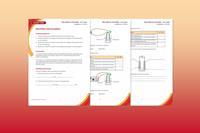Address one of the most common misconceptions in electrolysis: identifying the cathode and anode
This resource accompanies the article Power to the pupils where you will find hints and tips for avoiding and addressing more common misconceptions in electrolysis for learners aged 14–16 years.
Learning objectives
- Name the positive and negative electrodes in an electrolytic cell.
- Identify the positive and negative electrodes from diagrams showing the practical set-up.
- Explain how to identify the positive and negative electrodes in a circuit diagram.
Introduction
A common mistake when labelling electrolytic cell diagrams is memorising the position of the labels, rather than considering the terminals on the battery or powerpack.
In this activity learners will need to carefully consider diagrams to identify the positive and negative terminals and then the positive and negative electrodes.
Student worksheet
The student worksheet contains a mixture of fill-in-the-gap, multiple choice and labelling activities to address misconceptions and ensure that learners observe and consider the practical set-up for electrolysis with both a battery and a powerpack. Learners must choose the best explanation for identifying the electrodes in a variety of diagrams, including a circuit diagram with cell symbol.
More resources
- Investigate the electrolysis of aqueous solutions with this practical video and supporting resources for 14–16 year olds, including animations linking the macroscopic and sub-microscopic.
- Find five ways to explain electrolysis; from building good foundations to memorising the rules in this tricky topic.
- Bring electrolysis to life and demonstrate the movement of positive and negative ions with a simpler, safer version of this classic electrolysis demonstration.
- Enhance electrolysis practical work with this CPD article Practical electrolysis.
- Explore Zubera’s role as a research fellow to find a sustainable solution to recycle electric vehicle batteries.
Downloads
Identifying electrodes | Student sheet
Handout | PDF, Size 0.16 mbIdentifying electrodes | Student sheet
Editable handout | Word, Size 0.49 mbElectrolysis misconceptions | Teacher answers
Handout | PDF, Size 0.17 mbElectrolysis misconceptions | Teacher answers
Editable handout | Word, Size 0.43 mb



















No comments yet